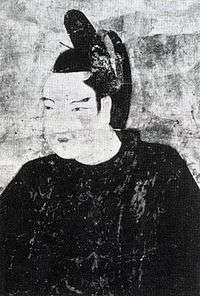Oda Hidenobu
Oda Hidenobu (織田 秀信, 1580 – July 24, 1605) was the son of Oda Nobutada and lived during the Azuchi-Momoyama period in the late-16th century. His other name was Sanbōshi (三法師).
Oda Hidenobu | |
|---|---|
 Oda Hidenobu | |
| Native name | 織田 秀信 |
| Born | 1580 Mino Province |
| Died | July 24, 1605 (aged 24–25) Mino Province |
| Allegiance | |
| Years of service | 1582–1600 |
| Rank | Head of Oda clan |
| Unit | |
| Battles/wars | |
| Relations |
|
| Other work | Buddhist monk |
Succession dispute
When Oda Nobutada and Oda Nobunaga, Hidenobu's father and grandfather, respectively, were killed during the Incident at Honnō-ji in 1582, there was a dispute as to who would rule the Oda clan between Oda Nobutaka and Oda Nobukatsu, the third and second sons of Nobunaga respectively. Toyotomi Hideyoshi settled the dispute by supporting Hidenobu. Though Hidenobu was only an infant, he was declared the heir.[1]
Battle of Sekigahara
Hidenobu followed in serving under Ishida Mitsunari during the Battle of Sekigahara in 1600. Before the battle, he had controlled Gifu Castle, an important element in Mitsunari's overall plans; however, he ended up losing the castle during the Battle of Gifu Castle against Ikeda Terumasa and Fukushima Masanori. After losing at Sekigahara, Hidenobu's vassals committed seppuku in Gifu Castle. The blood-stained floorboards eventually became the ceiling in Sōfuku-ji in Gifu. The ceiling is now called the Blood Ceiling.[2] Hidenobu himself died five years after the defeat at Sekigahara.
References
- Sansom, George (1961). A History of Japan, 1334-1615. Stanford: Stanford University Press. p. 311. ISBN 0804705259.
- Gifu City Walking Map. Gifu Lively City Public Corporation, 2007.